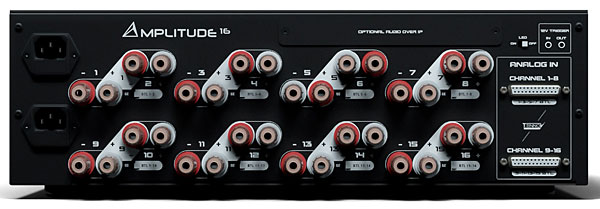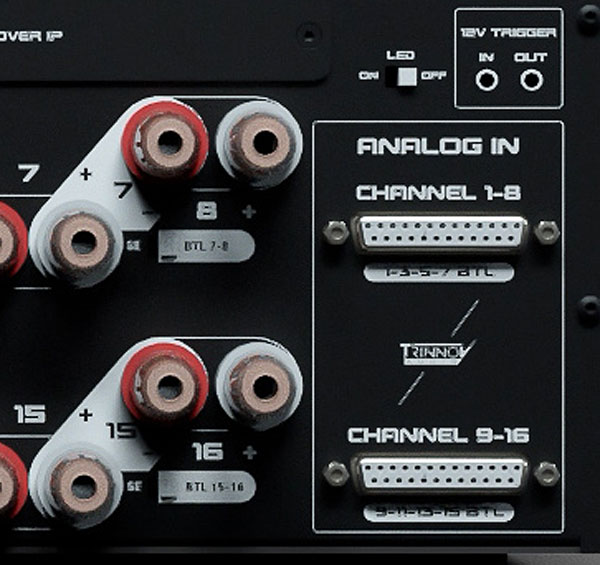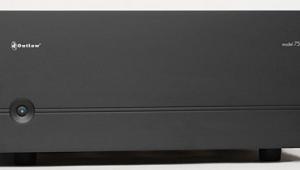Trinnov Amplitude16 16-Channel Power Amplifier Review

AT A GLANCE
Plus
Convenient one-chassis design
Superb dynamics and soundstage
Channels can be bridged to double the output
Minus
Amp runs hot
THE VERDICT
Trinnov’s Amplitude16 packs 16 channels of serious power in a standard size component and brings music and movie soundtracks to life in a thrilling way.
Last year I had the good fortune of reviewing Trinnov's Altitude16 surround-sound processor and loved it so much it became a permanent fixture in my A/V system. At the time, I raved about its performance and, after more than a year of daily use, I can honestly say that this 16-channel pre-pro is one of the best upgrades I've ever done in my theater.
So you can imagine how thrilled I was to have the opportunity to mate this fine specimen with Trinnov's Amplitude16, a striking 16-channel power amplifier the company describes as a "perfect companion" to the Altitude16 — a match made in heaven, aesthetically and electrically. The components share an almost identical brushed aluminum front panel and, as Trinnov points out on the product page, the amplifier's input sensitivity has been matched with the pre-pro's output level to "maximize dynamic range and signal-to-noise ratio."
Designed in partnership with Denmark's ICEpower, the Amplitude16 manages to squeeze two custom power supplies and 16 class-D modules in a rack-mountable chassis about 5 inches tall. In my case, this one box can replace the two ATI amps (also class-D but of the Hypex Ncore variety) I use to power nine of the 12 channels in my 7.1.4 Dolby Atmos setup. In case you're wondering (as I was) how they can fit 16 channels in a more or less standard size component, the credit goes to those ICEPower class-D modules, which have come a long way since Karsten Neilson invented the technology behind them back in 1999.
The virtues of the design are embodied in the ICEPower label, which stands for Intelligent, Compact, Efficient, and Power(ful). Though the details of how class-D amplifier technology works is beyond the scope of this article, suffice it to say class-D is way more efficient than traditional class-A, -B, and -AB amplifier designs in addition to running cooler and being much smaller and lighter, all of which explains how Trinnov was able to fit so many amp channels into a relatively compact package. Even so, when the Amplitude16 arrived, I was surprised the box weighed less than 50 pounds — I expected it to be at least 100 pounds. Sure, class-D amps are small and relatively light, but there are still 16 of 'em in there.
The front panel of the amplifier is clean and simple with only a power button in the bottom left corner and a spacious LED display to the right of center. The Trinnov icon at the bottom of the display changes color to indicate the state of the amplifier: red is off, waving green means the unit is booting up, and white means the amp is powered up and ready to rock. Above, there are 16 LEDs arranged in two rows of eight that show the current state of each channel: white is normal operation, red indicates clipping, and blinking red means the amp's protection circuits have kicked in.

The rear of the amp is simple — and unique. First off, there are two AC power inlets, both of which are required whether you're running a single amp channel or all 16 of them. Second, there are no RCA or XLR inputs. Instead, Trinnov provides two multipin DB-25 connectors (a.k.a. Tascam pinouts), which makes wiring the amp a breeze (more on that in a moment). Then you have the 16 speaker outputs, organized in eight odd/even channel pairs that run across the entire width of the back panel, a 12-volt trigger input/output and an LED switch to turn off the front display. Finally, there's a removable plate covering the slot for an audio-over-IP input board that will be offered as an option in the future.
Each output grouping has four binding posts (plus and minus for each channel) and a bridging switch that combines the channels for a serious bump in power when it's moved to its BTL position; the binding posts accept bare wires, spade lugs, or banana plugs. A white band in each grouping highlights where to connect the speaker wire when channels are bridged: the plus connector from the odd channel and the minus connector from the even channel. When two channels are bridged, the front panel display shows a solid line running between the LED for each channel to indicate they are paired. In bridged mode, single-channel output jumps from 200 to 800 watts into 8 ohms or from 400 to 1,000 watts into 4 ohms with less than 0.1% THD+ N at 1 kHz. Mighty impressive!

Cable-management is challenging under the best of circumstances, especially if you're using bulky XLR balanced cables, so Trinnov chose a different path for some of its products. If you're mating the 32-channel version of the Altitude processor (Altitude32) with the Amplitude16 amplifier, the connection for each group of eight channels is a simple matter of running a single cable with a male DB-25 connector on either end between the components. (I can't even imagine trying to corral 32 XLR cables!) Sadly, the Altitude16 in my setup doesn't have a DB-25 output so I had to settle for a hybrid solution using two sets of eight-channel cables with female XLR connections on one end (the processor side) and a male DB-25 connector on the other (the amplifier side), which still greatly simplified hookup on the amplifier end. (Trinnov sells these cables for $200 apiece.) As far as I'm concerned, DB-25 connections should be standard on all audio products.






























































